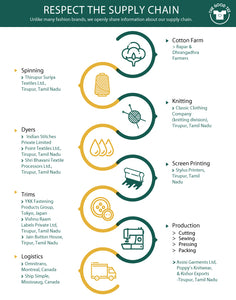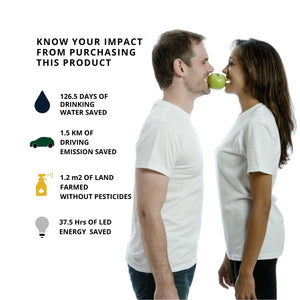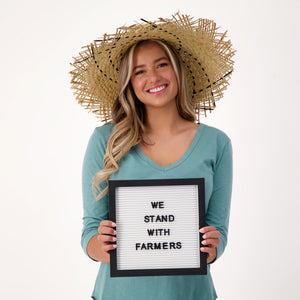How To Shop For Eco-friendly Clothing Like A Sustainable Superhero

Picking out the clothes we wear every morning may seem like a simple choice, but this choice is linked to a variety of far-reaching environmental, social, and economic impacts. We understand a piece of clothing as an everyday item – a basic human need – while the global fashion industry, mainly dominated by the fast fashion business concept in recent years, is one of the most environmentally and socially destructive industries in the world.
There are some important questions to ask ourselves when shopping for new clothes. Where was this garment made? Who created it? What is the impact of the materials used to make it? Will it last me a long time?
The answers to these questions set apart the profit-oriented fast fashion companies from sustainable fashion brands. To live a sustainable lifestyle, saying no to fast fashion and shopping from sustainable fashion brands is one of the best steps to take.
1. Invest In Classics & Quality
Is the piece of clothing you’re buying made to last? Will you be able to and want to wear the item you’re buying a few years from now?
Products made by fast fashion companies often end up in a landfill very quickly due to their poor quality, polluting our environment with waste.

Not only that – this is exactly the purpose of fast fashion: to make clothing you’ll throw away soon so that you have to replace it with new garments quickly and keep buying more.
Sustainable fashion, on the other hand, is creating garments with longevity in mind.
The goal is to craft a piece of clothing you’ll still be able to wear years from now. Because of that, sustainable fashion companies invest more money and time into adding strong stitching or durable buttons and zippers. More effort is put into picking out sturdy, natural materials and designing the garment for a well-fitting cut and easy maintenance.
2. Consider The True Cost
If your t-shirt costs less than a cup of coffee, then consider that a red flag. Someone, somewhere, is paying the price.
We’ve gotten so used to seeing a $10 t-shirt that we can’t fathom why a more sustainable one would cost over $40. That’s because the extra cost of the sustainable fashion garment isn’t going into the CEO’s pocket – it’s spent on higher-quality manufacturing, thoughtful design, fair worker wages or quality materials. Consider all the steps taken in the textile manufacturing process: from cotton picking, through spinning and weaving, to manufacturing of the final garment and logistics of delivery.
All these things contribute to a more sustainable product. The final price reflects that.
Fashion is now a 3 trillion-dollar industry - but in many parts of the world, people are not being paid enough to satisfy their basic human needs. Some sweatshop workers making garments for fast fashion brands are paid as little as 3 cents per hour. By purchasing a sustainably, ethically made t-shirt instead of a fast fashion one, you’re saying: ‘Everyone in the supply chain deserves to be paid for their work. A living wage is a human right’.

3. Consider the Price
Is the price tag on a piece of sustainable clothing holding you back from making the purchase? Does it seem tempting to just buy a similar-looking garment for cheaper at a fast fashion store?
You’re not alone in this struggle, we’re all drawn to a good deal – and fast fashion clothing usually costs less than sustainable garments. However, as it turns out, fast fashion clothing isn’t a very good deal after all. In the long run, sustainable fashion is the best deal.
The initial price you pay for a fast fashion garment may be cheaper - for example, a shirt may cost just $30. However, you might not get more than 5 wears out of the garment before the material starts fraying or seams start coming apart, making you not want to wear it any more. Therefore, in this case, the cost per wear will be $30 divided by 5 wears (the fast fashion average), which gives you the final cost of $6 per wear.
Let’s compare this to one of our bestsellers - the batwing tee - which is made ethically and sustainably. You’ll likely end up paying more initially - in this case, $57. However, you’ll likely end up wearing it at least 50 times (if not more - estimating you wear the item 4 times a month over 5+ years, which is a typical lifespan of a sustainable fashion garment, you’ll end up wearing it over 250 times). Calculating the cost per wear, you simply need to divide $57 by 50, which gets you to $1.14 per wear (if you were to wear the garment for 5 years, it would end up being $0.22). When you calculate the cost per wear, you can clearly see that a sustainable fashion garment is cheaper in the long run than a fast fashion piece.

More wear results in less waste being sent to the landfill. Additionally, it also helps reduce your carbon footprint - did you know that wearing a piece of clothing 50 times instead of 5 in any given year reduces your CO2 emissions by over 400% per item, per year?
The next time you’re shopping for clothes, consider the cost per wear rather than just the number on the price tag. When you consider the price per wear, slow fashion garments often end up being much lighter on the budget than fast fashion garments – because you get to wear them for much longer!
4. Choose The Right Materials
Do you know what fabric the garment you’re buying is made from? And what the impact it has on the environment?
Most fabrics can be categorized either as synthetic, or natural. Synthetic fabrics are made from crude-oil-based plastic, spun into yarn and woven into fabric. These fabrics are cheaper to make, which makes them popular with fast fashion brands, but have a severe negative impact on the environment. Because they’re made from plastic, the clothes release plastic fibers into greywater whenever washed. Additionally, plastic clothes never biodegrade – they only fall apart into more plastic particles.
Natural fibers, on the other hand, come from plants. Because of that, they don’t release any microplastics and biodegrade naturally when composted or sent to landfill. This makes them a much better choice for the planet.

Fabrics are also often dyed to make the final garment – it’s important to choose brands that use low-impact dyes that require less water and do not use any heavy metals if you want to reduce your impact on the environment. Another material involved in the process is packaging, ensuring it’s biodegradable or recyclable. At The Good Tee, we’ve specifically chosen to use the most sustainable materials, Organic Cotton, as the most sustainable natural fibre, eco-friendly dyes and packaging.
5. Check The Manufacturing Processes
Have you ever wondered what the journey of your t-shirt was like and the lives it touched? Do you know #whomademyclothes? Many of us have lost the connection between the clothes we wear and the people who make them. Yes, clothing is still made by people, not machines.

According to Fashion Revolution, only 23% of 250 companies reviewed meet the transparency criteria. Company transparency is key to learning about its impact on the people in the supply chain. Unsustainable companies are frequently hiding their practices, while sustainable fashion brands are sharing what makes them ethical and sustainable.
Look for videos of factories or detailed disclosure about suppliers, factories, materials, and partnerships. Unfortunately, good transparency is still not an industry standard.
6. Check The Labels
Certifications are awarded to sustainable companies by third parties, which have a set of criteria for these brands to meet. They ensure that the brand follows best practices in the area they’re certifying.
Without certifications, it can take quite some time to read up on the environmental, social and economic impact of a company – a trusted sustainability label does this for you so that you don’t have to.

Some of the best certifications to look out for are certified Fairtrade organic cotton and B Corporation. B-Corporation is a third-party audit and certification platform meant for sustainable businesses. Certified B Corporations are businesses that meet the highest standards of verified social and environmental performance, public transparency, and legal accountability to balance profit and purpose. At The Good Tee, we’re proud to be a certified B Corporation using certified Fairtrade cotton.
Before you buy, ask yourself a few fundamental questions. Do I want to support this company and its values? Am I voting wisely with my dollar? In the words of Vivian Westwood: ‘Buy well, choose well, make it last’.
Choose companies like The Good Tee, which tick all the boxes on your sustainability criteria list and stop supporting unsustainable fast fashion brands promoting overconsumption. Explore The Good Tee website to learn more about the brand!








Leave a comment